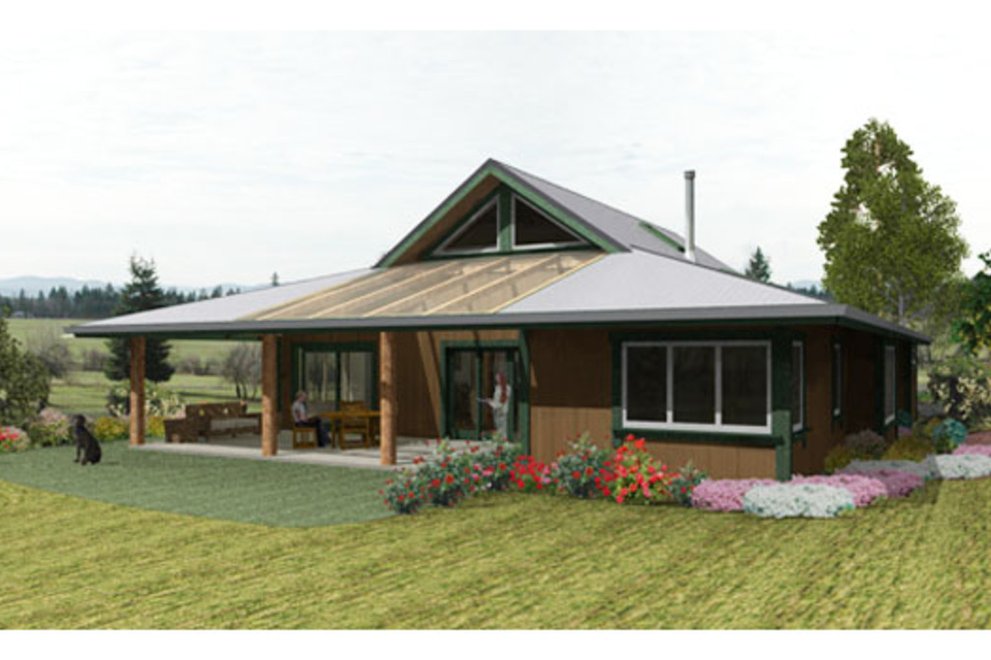The secret to getting the most for your money is using good, old-fashioned common sense -- as with the design by David Wright, above (Plan 452-1).
If you want to save energy, don’t build the largest home you can afford. Build a smaller, higher quality home, and build it right the first time, says Marc Richmond, founder and manager of the Austin, Texas-based green building consulting firm Practica Consulting. Richmond advises following the pyramid (see diagram below) and spending the majority of your money and effort on the lower tiers. “Invest in things that cannot be changed later and will payoff forever,” he says.
Back to Basics
In Richmond’s experience people spend money on too many expensive, energy-saving products instead of taking advantage of the much cheaper benefits of good passive solar architecture and good installation of the basics, including air sealing, insulation, HVAC design and layout, water heating, radiant barriers, and thoughtful home operations. “You can save an incredible amount by turning off lights, appliances, electronics, and your HVAC system when they’re not needed,” Richmond says. “For example, for every thermostat degree adjusted, you can save about 3 percent on heating or cooling.”
Choose the Right Plan
Select a house plan that is designed for your climate rather than one that is not. If you are building in a hot climate, Richmond recommends a plan with extended roof overhangs to shade windows, breezeways to facilitate exterior air flow, a layout that aids the natural flow of air between open windows in connected rooms, and operable skylights or cupolas to vent out rising interior hot air.
In addition, consider building short walls and fewer windows on the east and west sides of the home to reduce solar heating, and look for a plan with shaded and usable patios, as well as screened and covered porches, to create outdoor living spaces. You may also want to select a single story concrete slab home to allow the thermal mass of the slab to keep the interior cooler.
Building in a cold climate? Richmond suggests looking for a plan in which the south side of the house has the most windows to take advantage of winter sun. Also, think about choosing a two-story, compact home design to reduce the amount of external wall, which reduces heat loss. And consider eliminating a fireplace to further reduce heat loss.
Ask the Experts
One of the biggest mistakes people make when building a home is not having an expert help them make decisions. Don’t assume that your builder is oriented towards energy efficiency because builders tend not to be, according to Richmond. While building to code is the minimum legally required standard, Richmond advises shooting for much higher than code. There are a few green building experts in each region, he says, and they tend to sell advice and be product neutral.
If you want to save energy, don’t build the largest home you can afford. Build a smaller, higher quality home, and build it right the first time, says Marc Richmond, founder and manager of the Austin, Texas-based green building consulting firm Practica Consulting. Richmond advises following the pyramid (see diagram below) and spending the majority of your money and effort on the lower tiers. “Invest in things that cannot be changed later and will payoff forever,” he says.
Back to Basics
In Richmond’s experience people spend money on too many expensive, energy-saving products instead of taking advantage of the much cheaper benefits of good passive solar architecture and good installation of the basics, including air sealing, insulation, HVAC design and layout, water heating, radiant barriers, and thoughtful home operations. “You can save an incredible amount by turning off lights, appliances, electronics, and your HVAC system when they’re not needed,” Richmond says. “For example, for every thermostat degree adjusted, you can save about 3 percent on heating or cooling.”
Choose the Right Plan
Select a house plan that is designed for your climate rather than one that is not. If you are building in a hot climate, Richmond recommends a plan with extended roof overhangs to shade windows, breezeways to facilitate exterior air flow, a layout that aids the natural flow of air between open windows in connected rooms, and operable skylights or cupolas to vent out rising interior hot air.
In addition, consider building short walls and fewer windows on the east and west sides of the home to reduce solar heating, and look for a plan with shaded and usable patios, as well as screened and covered porches, to create outdoor living spaces. You may also want to select a single story concrete slab home to allow the thermal mass of the slab to keep the interior cooler.
Building in a cold climate? Richmond suggests looking for a plan in which the south side of the house has the most windows to take advantage of winter sun. Also, think about choosing a two-story, compact home design to reduce the amount of external wall, which reduces heat loss. And consider eliminating a fireplace to further reduce heat loss.
Ask the Experts
One of the biggest mistakes people make when building a home is not having an expert help them make decisions. Don’t assume that your builder is oriented towards energy efficiency because builders tend not to be, according to Richmond. While building to code is the minimum legally required standard, Richmond advises shooting for much higher than code. There are a few green building experts in each region, he says, and they tend to sell advice and be product neutral.






